Visual Arts and Fine Arts
We constantly see or hear the term "visual
arts." But which "arts" does this term mean, exactly?
First,
let's make clear that the term visual arts is
a contemporary rendition of the more traditional expression fine arts. Fine arts is
the translation of the French
term beaux arts, coined in the eighteenth century to describe
a limited number of visual media such as painting, sculpture, and printmaking.
This phrase is still used in association with these classical art forms,
where the word "fine" makes a reference to the purity of
the discipline.
Today, however, I would argue that the term "visual arts" better describes the
panorama of contemporary arts. The word "visual" expands the range
that the word "fine" limits, by including a number of current art
practices that are physically visible, such as photography, video, performances,
and so on. Of course, this opens up the possibilities ad infinitum. We could easily think that any object or performance can be classified
within the visual arts.
|
|
In
Corporation (2006) - Lucia
Madriz
By the means of animation, the artist incorporates classical pictorial
elements such as color palettes and silhouettes into a contemporary
"canvas":
digital video. Click
here to watch the video.
|
However, there is an important factor that differentiates the visual arts from other practices such as craft work, design, architecture, and fashion.
Applied Arts
At this point I would like to introduce a third term: applied arts.
All the fields mentioned earlier are considered applied
arts. But what
exactly is the division line between the visual and the applied arts?
Though the definition of these two terms changes and mutates according
to the historical moment, two constant factors mark the
difference: utility and aesthetics.
Design, craftsmanship, and the applied arts in general are characterized
by utilitarian goals that respond to basic necessities. For example,
architecture is a response to the necessity of shelter. The
final cause of the fine/visual arts is the art object itself. There is
no utilitarian goal in the creation of an art piece and no functionality
designed for it.
An art object appeals to our sensorial and emotional realm by calling upon our feelings and tastes at the moment of the appreciation. A craft, a design, or a building, on the other hand, appeals to our practical instincts by providing solutions that are imbued with creative ideals. Fine art stimulates our intellect, whereas applied art feeds our human needs.
|
|
Kuna woman with Molas (top)
and Mola shoes (bottom). Molas are a traditional hand-made craft
by the Kuna people in Panama and Colombia. Originally they were
part of the women's domestic customs,
but today they are sold to tourists in different forms. Aren't
my Mola shoes great?
|
Most of the time, the motive behind a creative process blends together the utilitarian and the purely artistic, and the output navigates between different categories. This means that the utilitarian aspect of the applied arts doesn't necessarily obscure the aesthetic quality within a craft. The intellectual aspect of fine arts lessens the utilitarian capability of an art piece.
Today, more than ever, the division line between the practical and the sublime is constantly overlapped. Visual artists repeatedly create connections with other creative disciplines to enrich their own practices and appeal to a broader audience. This is in contrast to the past, where fine artists created work for an educated elite. In actuality, art has become an effective platform for cultural exchange.
 |
Armchair, (ca. 1907–9) -
Charles Sumner Greene and Henry Mather Greene, made by Peter and John Hall's Workshop
Pasadena, California
The arts and crafts movement shifted art to include objects used in daily life. |
The following diagram shows my personal categorization of the arts. It also includes the performance arts, which we'll discuss in this lecture. This chart may help you to understand the complexity of contemporary art practices.
None of the practices are meant to be "greater" than any other. You may
also use the diagram as a practical reference to recognize different
influences in examples we will study later.
|
|
Click to enlarge the diagram.
|
Crossing or blending artistic categories is a phenomenon called interdisciplinary practice. I consider myself an interdisciplinary artist.
One of the most positive things about interdisciplinary practice is that
it reaches larger audiences. Today, spectators are "trained" to read
a vast number of codes that range from the visual to the acoustic and
from the intellectual to the sensorial. Interdisciplinary practice
also attracts a wider group of practitioners from more varied backgrounds than typically enter the visual
arts. Amongst my fellow artists I
can count musicians, video game programmers, writers, contemporary
dancers, fashion designers, disc jockeys, and photographers.
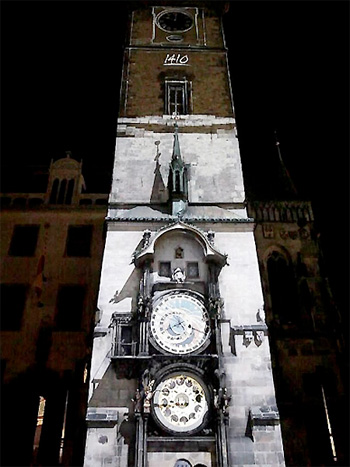 |
| Three dimensional video mapping is responsible for this amazing projection on Prague's medieval Astronomical Clock. Click here for video footage. |
The video below combines performance, movement art, and video for a stunning effect.
 |
| This piece, The Alchemy of Light, combines multiple disciplines for a stunning effect. Click here for the full video. |
The Arts and Crafts movement blurred the division between the fine and applied
arts. It developed in the late 19th century
and at the beginning of the 20th century, primarily in England and the
United States. The Arts and Crafts movement was influenced by John Ruskin's writings and paintings.
It reacted against the characterless and repetitiveness of
machine-made objects by turning towards handcraft.
Arts and Crafts artists also shared a
political position against the division of labor. They proposed
the idea of a master craftsman who would take part in all the stages of production. For these artists, objects should be practical and beautiful, as well
as affordable. Artists, designers, and architects like William Morris
and Frank Lloyd Wright, who were attached to the Arts and Crafts movement,
would influence later movements such as De Stijl and Bauhaus.
|
|
Artichoke
wallpaper (1897)
- John Henry Dearle
Dearle, a common artisan, designed this wallpaper for William Morris
and Co., a design firm that promoted an egalitarian affiliation
between artists and artisans.
|
Let's look at some of my favorite examples of crossover artistic
practices.
Fluxus
In 1962, the Lithuanian artist George Maciunas informally organized and named Fluxus. Taken from the Latin word fluxus=to flow, Fluxus was conceived as an attitude and a lifestyle, more than an art movement. It was based on collective thinking and practice and blended together different artistic media and disciplines like visual arts, performance, music, literature, sports, design, architecture, and urban planning.
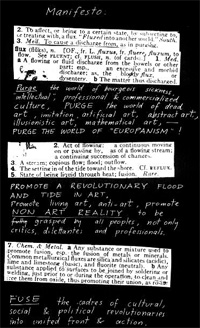 |
| The Fluxus Manifesto. Click here for larger version. |
Artists from all over the world made up part of this network. Notable artists included Joseph Beuys, Dick Higgins, Yoko Ono, Nam June Paik, John Cage, Allan Kaprow, and Wolf Vostell. Fluxus is generally considered to have spanned the period from 1962 until Maciunas' death in 1978. However, a group of artists today still work under the name and principles of Fluxus, keeping the Fluxus flame alive.
What really brought Fluxus to the attention of the media was a series
of events appropriately named Flux-festivals that took place during the 1960s and
1970s. These events were carnivalesque and playful. They consisted of brief
and simple actions that would elevate the mundane and the banal into a
radical gesture against high-academic art and market-driven music.
Flux-festivals
took place all over the western world: Copenhagen and Paris in 1962,
Düsseldorf, Hague, Amsterdam and Nice in 1963, London, NYC and Milan
in 1964, Prague in 1966, Zurich, Belgrade, Paris, Rome and several U.S.
colleges in 1967, and so on.
|
|
Ben Vautier (1964) photographed
by George Maciunas.
Vautier was performing a violin piece by Maciunas, wrapped in string
by Takehisa Kosgui. Performed during the street events of the Flux
Festival at 359 Canal Street, NYC.
|
The first Flux-festivals would be an amalgam of different events: a concert, a street performance, a showcase of objects, dancing exercises, and more. (When I refer to "concerts" here, I am not talking about a normal musical concert. A Fluxus concert was everything but normal. It included music scored by animals, music for lips, sounds made with mud, pebbles, balloons and other objects, pieces for piano that would end in the destruction of the instrument, and other unconventional sounds.)
In 1970, Maciunas would organize a Flux-festival in SoHo, NY in collaboration with Yoko Ono and John Lennon. It included a grapefruit banquet, funny tours and tickets, a measuring clinic, a garden-of-water event, and even the construction of different kinds of doors and film capsule-environments. Though these actions sound simple, they must not be interpreted as a gratuitous form of entertainment, but as a gesture that transcended the conventional boundaries of art and as a way of finding the creative and expressive potential of everyday life in a public space.
Later on, Flux-festivals would have a theme, so food-flux events, snow-flux gatherings, and ping-pong flux competitions took place. All this may seem pretty confusing, but that is exactly the purpose of Fluxus. Instead of rendering a clear-cut idea of a performance, they entertained the audience by presenting a number of elements for audience members to play with and reorganize, according to their own decisions and interpretations.
In short, they transformed the passive observer into a dynamic participant who carried the responsibility for finding some sort of meaning in the work.
To help you understand, or maybe confuse you further (!) I am copying below the artist Ben Vautier's own description of Fluxus, originally published in 1997:
"As far as I am concerned, I think that
Fluxus is not a production of objects, of handicraft articles to
be used as a decoration in the waiting rooms of dentists and professionals.
Fluxus is not professionalism, Fluxus is not the production of works
of art, Fluxus is not naked women, Fluxus is not pop art, Fluxus
is not an intellectual avant-garde or light entertainment theatre,
Fluxus is not German expressionism, Fluxus is not visual poetry for
secretaries who are getting bored.
NO Fluxus is the "event" according to George Brecht: putting
the flower vase on the piano. Fluxus is the action of life/music:
sending for a tango expert in order to be able to dance on stage.
Fluxus is the creation of a relationship between life and art, Fluxus
is gag, pleasure, and shock, Fluxus is an attitude towards art, towards
the non-art of anti-art, towards the negation of one's ego, Fluxus
is the major part of the education as to John Cage, Dadaism, and Zen,
Fluxus is light and has a sense of humor.
If you want to know more about this multi-faceted collective, check out this complete resource online: http://www.fluxus.org/
Gorillaz
I bet many of you have heard about the British music band "Gorillaz."
Their debut album "Gorillaz" launched in 2001. It included the
smash hit "Clint Eastwood" and earned them an entry in the Guinness
Book of
Record as the Most Successful Virtual Band. Virtual band? Yes, Gorillaz
is a virtual band, composed of four animated cartoons: Murdoc, Noodle,
Russel, and 2D. The British musician Damon Albarn (frontman of the
band Blur) and artist Jamie Hewlett (best known for Tank
Girl) are behind the band.
Gorillaz started to release songs in the underground London scene around 2000. They generated a lot of mystery about their true identity. Relying on this expectation, Albarn and Hewlett circulated with their first promo a booklet that contained a fictional back-story behind the cartoon band. The truth is that many other musicians and artists were involved in the development of the band, with the only constant being Albarn performing the singing voice for 2D in every song.
The official Web site for the band (http://www.gorillaz.com)
gives you access to the fictional Plastic Beach, videos, and current music. The Web site is a great example of the visual arts component of a band playing just as important a role as the musical
part. Comic design, graffiti, computer animations, and video games
are some of the visual media Hewlett combines in this interactive
site.
|
|
Check out Plastic Beach at gorillaz.com.
|
Gorillaz' live shows make them a fine example of overlapping disciplines. The group combines different visual effects to project the virtual band onstage. Their latest technique consists of using giant transparent film to project 3D animations, while having special guests performing live on stage. This creates the feeling that the actual band members are present on the stage. This kind of performance earned Hewlett the 2006 UK Designer of the Year Award.
Other projects by Gorillaz are a series of animated short films called
"Gorilla Bites," compiled in a DVD collection. They have also released
"Rise of the Ogre," a full-color book containing the full story of
Gorillaz.
The British/Turkish Cypriot fashion designer Hussein Chalayan often
creates visually-challenging experiences in his designs. His collections
and catwalk presentations can be defined as both art installations
and fashion statements. He borrows from architecture, performance art, sculpture,
photography, video, electronics, and environmentalism to design minimal
silhouettes that are both provocative and intense and experiments with
all kinds of materials.
I had the good fortune of being in an exhibition with Chalayan and his work just blew me away. One work consisted of a "paper Airmail dress" made out of un-tearable paper fabric. The work arrives as a letter and unfolds to become a full-length garment, which you can wear, write on, and mail out. The dress changes as it passes from hand to hand; each wearer writes messages on the dress, making the clothes-wearing experience a collective chain of messages.
His Cutting-Edge Living Room collection (2000) consisted of a set of wooden chairs and a coffee table that models actually wore! The table skirt is especially ingenious made out of wooden rings that fit into each other, forming a table when the model kneels down.
His collections are sold in over 160 stores worldwide and his work is exhibited
in major museums and art galleries. He has declined powerful positions
in the fashion industry to remain true to his original ideas. As he
puts it in an interview with the British paper The Telegraph:
"Why shouldn't you use DNA and archaeology as reference points?
Art and fashion do relate to math and physics. They are all disciplines.
It's just that we haven't
been educated to see the connection."
Investigative Art
For the American artist Andrea Zittel, art is just another form of investigation.
Her work involves designing spaces and everyday objects according to an individual's precise needs. She is a sort of a lifestyle consultant, providing solutions to problems such as lack of space, disability, allergies, and so on. Her art work takes on forms of cupboards, wagons, containers, furniture, clothes (uniforms), interactive sculptures, compartments, home units, and vehicles. She also produces prints and drawings that follow a more traditional approach.
A researcher by nature, Zittel has experimented with a great number of materials and techniques, making her one of the most prolific artists of today. Trained as an artist but fulfilling many different and changing roles, she continuously jumps between disciplines like architecture, art, fashion, interior design, and furniture design. Her workshop, or testing ground, composed by herself and several assistants, is known as A-Z Enterprise. In her studio she designs, develops, and builds all her prototypes.
In the early 1990s, A-Z created a series of self-contained Living Units.
A Living Unit is a wooden trunk that unfolds into a structure that contains
every necessary element to live a normal life: a bed, a desk, a kitchen,
a bathroom, storage facilities, and a socializing area. These Living
Units were designed for specific individuals according to each person's personality
and lifestyle. Though they shared a common structure, each Living Unit
was conditioned and adapted to his owner.
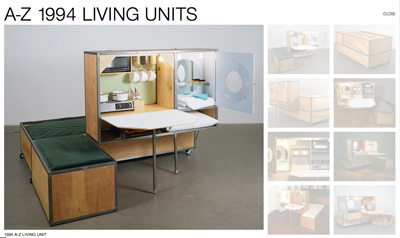 |
Andrea Zittel's Living Units and other works are
on display at zittel.org. |
Zittel rejects being classified as an industrial designer or as an architect. For her, these professions mean you have an obligation to the people. As an artist, she has a lot more freedom—if a project doesn't work or proves not useful, she moves on. She is not afraid of failure; instead she looks to unsuccessful works for inspiration. In this sense, we can consider her a utopian in search of alternative ways to make life better, easier, and more enjoyable.
Art as Contemporary Dance
The Catalonian dancer who goes by the name of La Ribot transcends the boundaries between contemporary
dance and the visual arts. Trained as a dancer, she occupies the artistic
space par excellence—the white cube—to present her "distinguished
pieces." In 2001, I had the chance to assist at one of her performances
at the South London gallery in London. I am not a fan of contemporary
dance. However, I was curious about La Ribot's practice because it is outside the realm of formal classification.
Around 20 people attended the gallery, which made it an intimate setting. There were no chairs provided for us, so we simply had to stand around or sit on the floor. We had the liberty of occupying any place in the gallery. The space was full of different objects, little toys, pieces of clothing including dresses and shoes, a little boom box, a chair, papers, a cardboard box, wigs, felt-tip pens, pieces of fabric, cutlery, and some porcelain articles.
La Ribot entered the space naked and started interacting with the objects in the gallery. Her dance training was pretty obvious, as she had total control over her movements though they were a product of improvisation. She would play some music, put on some clothes, assume a twisted position, and stay still for a few minutes.
At the beginning, I felt like she was a living sculpture, but as the performance went on, La Ribot began to express different human passions like boredom, sadness, joy, love, lust, and anger, making me think of a silent movie star.
|
|
Still
Distinguished (2000) -
La Ribot
La Ribot opens herself to the audience, shattering conventions
about how women should present themselves in public.
|
La Ribot also used her naked body to test different tensions between the
visual arts, performance, body art, and dance. By interacting with the different
elements scattered around the gallery she would create images that
traced historical moments of fine arts. She would reenact a still life,
or jump gaily around in the tradition of rococo tableaux vivants. She
would tie herself up with string, like a mail packet, and rub tomatoes
and garlic over her body. She explored several possibilities of the
naked body as an expressive tool and a medium for visual communication.
La Ribot uses her body as the main vehicle for expressing her personal vocabulary of visual arts and as the main bearer of ideas and emotions. She sells her performance as an art object, alluding to the commercialization and exploitation of the female body. However, she has the power of transcending any clichés of female representation by acting so near to her audience; you can appreciate the quality of her skin, and the imperfect features of her extremely thin body. You hear the rhythms of her breathing and see the sweat caused by her movements. Her nakedness is not scandalous; instead, it has an ironic power, sprinkled with a bit of humor.
Game Art and Open Source Modding
Parangari Cutiri is the alter-ego of California artist Anne Marie
Schleiner. Cutiri is a video game programmer and a militant of digital
open source
practices. She approaches net culture in different roles: as a writer,
critic, curator, hacker, and game designer.
Open source promotes access to the software's source, allowing users
to modify the software and redistribute it back into a community. This
has proved to be an alternative to centralized models of development
used in commercial software, enabling different approaches to production
and distribution.
In the mid 1990s, Cutiri was one of the first artists to incorporate
video game language into her work. She started by programming game
mods, or game modifications (also called patches). Game patch or mod
culture consist of creating plug-ins for a commercial video game. One
of the most popular was NudeRaider, a mod that strips down Lara Croft, the
Tomb Raider heroine, so you can play the game with the character naked.
Patches work as viral entities and are an exclusive
Internet phenomenon, programmed by underground hackers and distributed
and exchanged freely on the net. They spread fast amongst gamers, quick
enough to avoid standardization by game publishers.
One of Cutiri's most infamous patches is the Epileptic Virus Patch (1999), created as a plug in to Marathon Infinity, a game distributed by Bungie Software. The patch transforms the Marathon scenery into one of pulsating pixels and strobe lightning. These effects can cause eye twitches and epileptic seizures in people who have spent large amounts of time in front of a computer. This patch is especially interesting as it jumps the boundaries between hardware and wetware (the human central nervous system), hosted by digital machines and humans, respectively.
|
|
Epileptic
Virus Patch (1999)
- Parangari Cutiri
On her site, Cutiri warns: "This game patch will induce epileptic
seizures in the information weary."
|
Cutiri's latest work has gotten her into a lot of trouble with the
FBI, who censored it and deported her programming partner back to Mexico.
Corridos is the name of this open source video game that can
be downloaded for free. As a player you are an illegal immigrant trying
to smuggle
arms and drugs between the Mexican city of Tijuana and the American
city of San Diego. You have to drive a car quickly through narco-tunnels
constructed across the borderline. The FBI was concerned about this
game, as it actually portrayed a very real problem: Since 2003, 23 tunnels
have been found in the states of Arizona and California, though they weren't large enough to hold a car.
According to the FBI and the DEA, Corridos promotes illegal activity,
smuggling, narco-terrorism, and criminality. I find this position totally
absurd as the game market releases hundreds of violent games that include
killing people, taking drugs, going to war, and bombing whole villages
and other criminal, murderous acts. Think about the game Grand
Theft Auto, in which the player's objective is to steal cars and drive
around causing havoc. Cutiri and her partner Luis are actually living
in Mexico City
and have started a court plea in order to revoke Luis' deportation
and the five-year prohibition entry to the U.S. territory.
To download Cutiri's patches and video games, and to read her theoretical
analysis of digital counterculture, visit her Web site at:
http://www.opensorcery.net/
And now let's turn our attention to our interview with the artist Anne Marie Schleiner:
Feature Interview | Anne Marie Schleiner
Name: Anne Marie Schleiner (a.k.a.Parangari
Cutiri)
Occupation: Internet/computer/video/
game artist, teacher |
 |
Q: Briefly define/describe your artistic
production and the media you use.
I am a digital artist. Much of my work samples commercial
computer
games, reworking them for fine art purposes.
Q: What kind of issues do
you address with your work?
My work addresses issues like the militarization
of civilian entertainment in the United
States and the blurring of boundaries between virtual game spaces
and "real" urban
spaces. I have had a longstanding interest in the politics of representation
in computer games, online gender-bending, and experimental game
aesthetics.
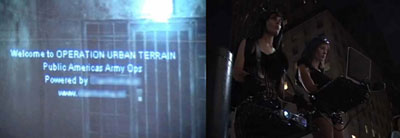 |
Operation
Urban Terrain (2004)
A
live action wireless gaming urban intervention, performed during
the Republican National Convention
in NYC. Two
women in gear are on the ground, one with a laptop and another
with a projector, hacking servers of popular online military
game AARMY. |
Q: How and when did you get involved with the open source
practice?
In the late 1990s, I became interested in free game modifications
that were available online, a trend kicked off by Doom's
release of their game code on the Web in 1993. I try to use open
source software whenever possible in my art production, using
software like Blender and
Processing.
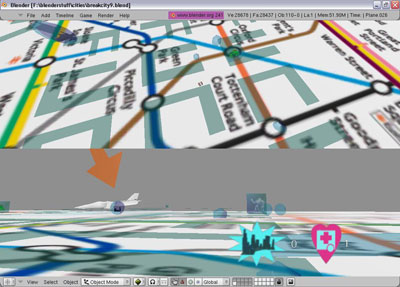 |
B-Cities (2007)
- Level 2: London tube map
Made with the Blender open-source game engine. Roll and destroy
cities through three abstract levels. There is a dizzy
split screen of simultaneous
side view, arial view, and in the trenches third person view.
|
Q: Where is the digital art practice positioned right now within
the artistic scene?
Digital practice is kind of marginal in the contemporary
art world. Many
collectors in the commercial scene find the work difficult to
collect
since there is no "object," although with video this
is changing thanks to the practice of selling limited editions with
certificates.
In the 1990s, net art was kind of anti-commercial, purposefully
avoiding the whole art market scene and putting work for free viewing
available on the Internet. Others within the contemporary art world
find much of the work too "technical," focused
more on techie design-type concerns and less on conceptual issues.
Some big digital art festivals are pretty commercial, like Ars
Electronica in Austria, where world's fair engineering industry prototype
is the exhibition mode. As with any new medium, I think there will be
gradual acceptance—it wasn't until the 1970s that video was considered fine art.
Q: How do you adopt different disciplines
(music, theater, grafitti, VJing…)
into your own creative process?
I am inspired by popular art forms and like the idea of DIY (do
it yourself) art forms made by regular people, not just fine artists
with fine art backgrounds. Originally, I became interested in DIY
art forms on the Web like homemade games and erotic interactive anime dolls
but I am also fascinated by older DIY forms like graffiti
and hip-hop lyrics.
VJing is an interesting convergence of visual digital design experimentation
and sound and I like the performance-oriented live aspect, something missing
sometimes in net art. (Which is usually kind of an intimate experience with you and your computer—it doesn't translate
too well in exhibition galleries.) I borrow freely from different popular art forms in my own process—you could see it as a form of stealing,
but I think of it as an homage to the masters and mistresses of
these forms, and to the forms themselves.
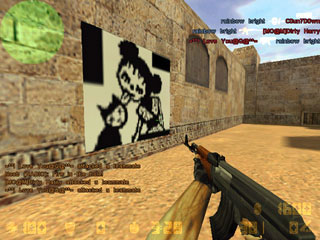 |
Velvet
Strike (2002)
A collection of spray paints to use as graffiti on the walls, ceiling
and floor of the popular network shooter terrorism game Counter-strike.
|
Q: How
does a video game, Web page, or game mod become a work of art?
I think
it's all about the purpose, the intended audience, and finally, the context.
Most commercial games or Web sites, even if beautifully made, I
would not call works of fine art. When they have messages and modes
that transgress just entertainment then they can become
art. Sometimes, like I was saying earlier, popular DIY art is very
inspirational and in the online "shows" I have curated
I like to include curious and amazing digital artifacts (game mods) that perhaps the authors didn't even think of as art—so
that is when context becomes important, invoking Duchamp's found
objects (the context, instead of a white cube
gallery, being an artsy net art show—like my first
online show "Cracking
the Maze: Game plug-ins and patches as hacker art"—with
fine artworks mixed with popular artworks).
Q: What are the
benefits of exposing your work online?
You can disguise
your art as not art, which causes people to take it more seriously if you are dealing with prickly political
issues. (Yes, Men, and Rtmark are masters of this technique—like the
fake Web sites
they made for George W. Bush and for the WTO). Also, even
if you don't engage in subversive art tactics, you can
reach beyond the elitist art-going public who go to galleries, and
get a lot more international exposure for your work than you could by just showing
it in a gallery. Also it's a great way to meet other artists around
the world who you might want to collaborate with, or who share your
interests.
Q: How does an understanding of traditional or historical
art influence your work? What traditional art techniques,
like
figure drawing or color selection, do you find useful in your non-traditional
work?
I do think it is important to contextualize digital art in the history
of fine art but I think it grows more out of time-based, ephemeral,
non-object-oriented art movements like performance
art, conceptual art, and video. The more design-influenced aspects
of digital art, like the popular open source program Processing,
are however greatly influenced by the formal modernist visual techniques
of drawing and color. I personally have two artist personas (something
easier to do if you are a digital artist). One is more political
and conceptual and the other (named Parangari Cutiri) is more musical,
visual, and design-focused.
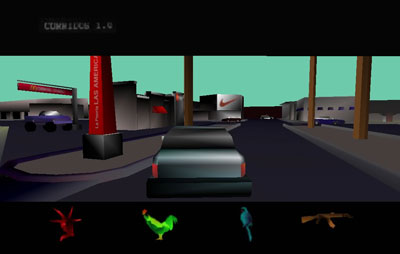 |
Corridos (2005)
Drug
trafficker folk music game.
|
Q: Name some of your influences and inspirations.
The Parisian Situationists
have been a major influence more recently in thinking about intervening
in urban spaces in playful, performative ways. The net artist group Jodi when they first started
making their hackerish-looking sites in the 1990s were inspirational.
Feminist photographers playing with identity and gender issues
like Cindy Sherman and Barbara Kruger, and performance
artists—William Wegman's early video works (his humor) and "activist" artists like
Joseph Beuys, Carolina Caycedo, and No Mango, the
beautiful game modifications of retroyou.org. ...there are many inspirations
and I have been lucky also to have had the opportunity to collaborate
with many artists who inspire me. Recently, I read a captivating biographical
book (Masters of Doom) about the two creaters of Doom and their white
and brown trash lives and early obsessions with computer gaming
growing up in the United States in the 1980s.
Q: What advice would you give
to someone who wants a career as an artist or game designer?
Well,
the two are actually quite different career paths (though there
is occasional crossover). For those who want to get
into game design, I recommend using free tools
available like Blender and Ogre to create your own games for your portfolio (you can collaborate
with like-minded friends) and to do a couple
of internships at game companies—even if you aren't paid right away,
it is valuable experience.
Play lots of games and take programming,
3D modeling, and animation classes. The game industry has specialized
work roles and only a few get to become "game
designers" who get to put forth their own
vision and ideas—and even they have many
commercial constraints—it's long hours
and lots of grunt work but also can be fascinating.
Women are lacking in the industry and they need
you.
Some years ago I heard some game industry
types say that as far as hiring what they call "artists,"
the people who do the visual stuff for games, [they] look for accomplished visual and creative
portfolios over technical skills, since technical
skills can always be learned, but visual talent
not as easily.
As for artists, I recommend exploring
as much as you can of the stuff that's already been done and is out there on
the Web, working on your own pieces in which
you challenge yourself conceptually and visually, and in terms of
reception and audience, and looking for education and internship opportunities abroad that may bring
you into contact with new ideas and other interesting
contemporary artists.
As an artist, it might be good to follow a parallel career as an art teacher since
sometimes its hard to survive solely from your art. For both cases,
I would say don't be afraid to try new things and fail. Put your ego
out there and let yourself get stepped on because that's how you learn. Many
artists are afraid and just make pretty nice things, or they are
eaten up by paralyzing neurotic self-doubt all the time.
Yes, some
of these people are my friends and are great artists actually, and
they often tell me I am not enough of a perfectionist but there is
a time and place for perfectionism and another
time for experimenting with new stuff.
Let's wrap up this lecture by summarizing what we've learned about artists in society.
Throughout history, there have been many different approaches to the role of artists in society.
The artist as an image-maker and creator of aesthetic pleasures has been the predominant approach. For almost twenty centuries, the traditional fine arts were the main manifestation of art. However, with the development of photography and cinema, the context for visual thinking has enlarged and begun to absorb other cultural lexicons.
During the twentieth century, the arts literally exploded into a vast
and complex network. Today, many artists intertwine different disciplines, which characterizes contemporary art. The reach of
the visual arts today expands to include a wide range of contexts, from market
circuits, fairs, corporate museums and biennials, to counter cultural,
underground, independent, and hacking activities. Art events range from
sponsored public art projects to intimate personal gestures. Art can
be approached in many ways and offers an individual many forms of creative
expression.
|
|
Chigate in concert at Sala
de eStar (2004) - Seville.
Chigate is an experimental digital punk music group from Seville.
It consists of painters, singers, musicians, and TV producers.
Their concerts involve video projection, experimenting with noise,
and live flamenco singing.
|
As we can see in the examples given along the lecture, many artists
approach the arts as a lifestyle, making their artwork a channel
for communication and exchange, delivering ideas that challenge culture
and visual thinking. However, many people approach art in a lighter
way, as a hobby that brings a new dimension to their everyday life.
This approach normally involves traditional fine arts media, like painting
and drawing.
Many schools and community centers offer art courses
that help an individual develop different techniques. This visual education
is very important in the consolidation of an audience who better understand
artistic efforts.
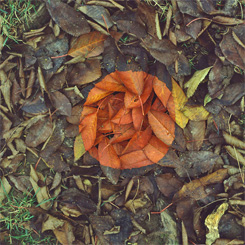 |
 |
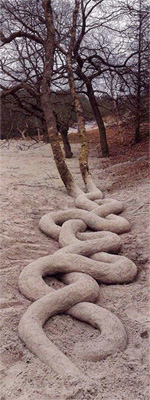 |
| Andy Goldsworthy creates beautiful and temporary site-specific sculptures using only natural materials found on site. To see more of his work, go here. |
Other artistic approaches that relate to everyday life are those that
reclaim the public space, or gaps left open by the system. Graffiti
art is one of the finest examples of the artist appropriating the public realm.
I personally find a repetitive graffiti tag in the street more attractive than
an overproduced ad campaign. The first is an individual gesture of
discontent, vandalism, or poetry, while the latter is a commercial
output of capitalistic economic structures.
|
|
Displaced
in Aranjuez - Franco
The Colombian graffiti artist Franco comments on the harsh reality
lived by the displaced people of the drug war in Colombia.
He also combines graffiti with fashion, skate culture, rap,
and graphic design. To see more of his work, go to myspace.com/fcolombia.
|
Fortunately, individual approaches to art seem to grow in all directions
and the cultural map expands into new realms including
science, literature, sports, and even cosmonautics. The contemporary art
scene is a rich patchwork of ideas and forms. In a personal way, I
approach art as a tool for learning about social relationships and
communication strategies. For me, each project is an experiment where
I test my own capacities and look for alternative ways of thinking
rather than fixed concepts.

